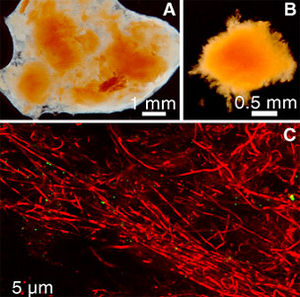Meiothermus: Difference between revisions
No edit summary |
No edit summary |
||
| Line 36: | Line 36: | ||
==Description and Significance== | ==Description and Significance== | ||
[[Image:meioslime.jpg|thumbnail|300px|Figure 2. ''Meiothermus "slime"''. Image from Marko Kolari [http://www.biocenter.helsinki.fi/groups/salkinoja/page4.htm]]] | [[Image:meioslime.jpg|thumbnail|300px|Figure 2. ''Meiothermus "slime"''. Image from Marko Kolari at the University of Helsinki [http://www.biocenter.helsinki.fi/groups/salkinoja/page4.htm]]] | ||
Before the recognition of the genus ''Meiothermus'', the species under the genus ''Thermus'' were designated as either high or low-temperature species. The proposal of a new genus ''Meiothermus'' in 1996 was made to designate the phylogenetic, phenotypic, and chemotaxonomic distinctiveness of the species that have low optimum growth temperatures. ''Meiothermus'' indicates an organism living in a "less-hot" place [1]. ''Meiothermus'', is a Gram-negative, aerobic, and variable in length - often forming short filaments. | Before the recognition of the genus ''Meiothermus'', the species under the genus ''Thermus'' were designated as either high or low-temperature species. The proposal of a new genus ''Meiothermus'' in 1996 was made to designate the phylogenetic, phenotypic, and chemotaxonomic distinctiveness of the species that have low optimum growth temperatures. ''Meiothermus'' indicates an organism living in a "less-hot" place [1]. ''Meiothermus'', is a Gram-negative, aerobic, and variable in length - often forming short filaments. | ||
Revision as of 01:41, 11 April 2011

Classification
Domain: Bacteria, Phylum: Deinococcus-Thermus, Class: Deinococci, Order: Thermales, Family: Thermaceae
Species
|
NCBI: Taxonomy |
- Meiothermus chiliarophilus
- Meiothermus cerbereus
- Meiothermus granaticius
- Meiothermus rosaceus
- Meiothermus ruber
- Meiothermus rufus
- Meiothermus silvanus
- Meiothermus timidus
- Meiothermus taiwanensis
Description and Significance

Before the recognition of the genus Meiothermus, the species under the genus Thermus were designated as either high or low-temperature species. The proposal of a new genus Meiothermus in 1996 was made to designate the phylogenetic, phenotypic, and chemotaxonomic distinctiveness of the species that have low optimum growth temperatures. Meiothermus indicates an organism living in a "less-hot" place [1]. Meiothermus, is a Gram-negative, aerobic, and variable in length - often forming short filaments. Describe the appearance, habitat, etc. of the organism, and why you think it is important.
Genome Structure
Describe the size and content of the genome. How many chromosomes? Circular or linear? Other interesting features? What is known about its sequence?
Cell Structure, Metabolism and Life Cycle
Interesting features of cell structure; how it gains energy; what important molecules it produces.
Ecology and Pathogenesis
Habitat; symbiosis; biogeochemical significance; contributions to environment.
If relevant, how does this organism cause disease? Human, animal, plant hosts? Virulence factors, as well as patient symptoms.
References
Author
Page authored by Michael Huarng and Steven Huynh, student of Prof. Jay Lennon at Michigan State University.
<-- Do not remove this line-->
